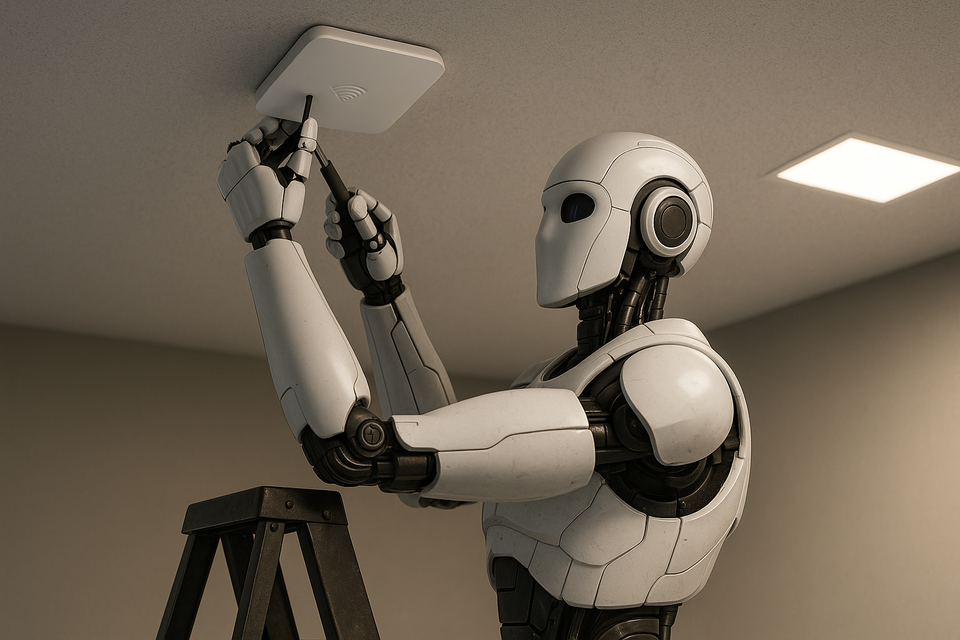The Coming of the Machine: Robots, Servers, and the Edge of Dominion

For years, we’ve imagined robots as chrome-plated fantasies — Hollywood’s I, Robot, Japan’s humanoid helpers, Boston Dynamics’ dancing machines. But reality is creeping closer. Step by step, circuit by circuit, the robots are arriving. The question is not if they will dominate the physical layer of our world, but how they will do it, and who will control them when they do. What we are building right now will define the next century: the balance between distributed intelligence and centralized tyranny. And make no mistake — the difference is survival itself.
—
Robots as the Natural Expansion of the Server
We already live in an age of servers. Every home with a Plex box, every business with a NAS, every enterprise with racks of AI-driven analytics — all of them are proto-nervous systems waiting for a body.
Robots are not the birth of a new species. They are the extension of the servers we already own.
In the Home: The home server will command not just your files and media, but the robot vacuum, the robot cook, the robot caregiver.
In Business: Edge servers already manage workflows, automation, and data pipelines. Adding robots is the next step — hands and legs to execute what the system thinks.
In Enterprise: Datacenters crunch the data of entire industries. Now they will also deploy fleets of industrial bots — mining, construction, logistics, security.
The robot is not an alien intelligence. It’s just the body that servers have been waiting for.
How They’ll Work: The Thought Stream and Sensory Stream
Forget the Hollywood fantasy of a “self-contained AI brain.” That’s a trap. Centralized brains create centralized collapse.
The real architecture will look like this:
- Onboard AI
Cameras and sensors feed into local processors.
Every frame is decoded into text, a thought stream:
“Person of [size] detected at location x, y, z, 3 meters away, moving left at 2 m/s.”
“Red object of [size] at location x,y,z. 2 meters, probable fire hazard.”
This text updates once per second, a compressed reflection of reality, if not faster.
- Home/Enterprise Server AI
The thought stream and sensory stream flow back to the local server at 3–10 Mbps.
The server handles heavy reasoning, task assignment, and coordination between robots.
The server reconstructs a 3D model of the world from either text descriptions or raw feeds.
- Skills Stored Locally
Everything the robot learns is stored on your server.
Teach it to clean your kitchen, it remembers.
Show it how you like your coffee, it never forgets.
Your personal AI grows in your domain, not in the cloud.
This means your robot isn’t a corporate spy. It’s your student.
Networking the Machine
Robots breathe through networks. If their network is controlled by corporations or governments, so are they.
Why 5G Isn’t It
5G promises speed, but it’s a chain:
Fixed towers.
Licensed spectrum.
Centralized routing through telco backbones.
That’s not freedom — that’s dependency.
The Real Solution: Long-Range WiFi Mesh
Lower-frequency WiFi with custom protocols. Stronger penetration through walls, longer range.
3–10 Mbps per robot, enough for thought streams and sensor feeds with millisecond latency.
Mesh expansion, where each access point extends the range organically.
And here’s the prophetic twist: the first task of a household robot should not be vacuuming or cooking.
It should be building its own nervous system:
Mounting access points to walls or ceilings.
Wiring or configuring them.
When the robot can build its own network, it ceases to be a toy and becomes infrastructure.
Perception, Memory, and Skills
The power of these machines will not just be in motion — but in memory.
Perceptual Hashing: A robot can look at a product, hash its visual identity, and instantly pull instructions from a database. How to clean it, fix it, assemble it.
Personal Skill Libraries: Robots will not just download pre-trained skills. They will store the things you teach them, unique to your household, your factory, your office.
3D Reconstruction: Over time, your robot will know your world as well as you do. A full spatial memory that can be used to plan, predict, and act.
This is not just automation — it’s apprenticeship.
Where Should Robots Live?
Here lies the great debate.
In the Home: Robots as caretakers, companions, assistants. A natural extension of the home server.
In the Business: Logistic helpers, security patrols, hands for the digital workflows already running.
In the Enterprise: Factories, mining pits, high-rise construction sites — places where human bodies are burned out and discarded.
And the darker possibility: Overseas deployments, using robots as remote laborers in warzones, colonies, or hostile environments. Do we keep them far away, or do we bring them into our most intimate spaces?
The closer they get, the more ownership and control matter. If you don’t own your robot’s server, you don’t own your robot.
The Prophecy of Function
If the future of robotics is survival, then their first jobs must be survival tasks:
Building the network they rely on.
Securing the infrastructure they inhabit.
Extending human reach into danger — mines, disasters, high-rises, nuclear ruins.
Only then can we trust them with softer tasks: cooking, cleaning, caring.
The prophetic warning is this: If we build robots as slaves of the cloud, we will be the slaves of the cloud through them. If we build them as extensions of our own servers, our own minds, our own domains — then they amplify us, instead of replacing us.
Conclusion: The Edge of Dominion
Robots are not coming to liberate humanity. They’re coming as the next stage of control. The only question is: who controls them?
If it’s a centralized brain, we inherit chains.
If it’s a distributed network — servers in our homes, our businesses, our hands — then we inherit tools.
The first robot should not set your table. It should climb step, mount your access points, and build the nervous system it will live on.
That is when the machine ceases to be fiction and becomes destiny.
BSHP
blacksheephackerprophet.blog






Member discussion